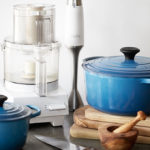 Follow These Easy Steps To Successfully Avoid Sources of Hidden Gluten
Follow These Easy Steps To Successfully Avoid Sources of Hidden Gluten
Let’s begin by taking a deep breath and highlighting that as long as this list may be, it’s not as complicated as it seems at first. In fact, if you eat or set out to transition into a whole foods diet, you won’t have any trouble crafting a delicious daily menu for yourself or a gluten free family member.
The list of gluten free grains and foods is far more exciting then the no-no’s listed here. Just take a look at my archive of 100% gluten free recipes to get a taste. However this guide will be a crucial reference as you begin to navigate which sneaky foods contain gluten. Many benign sounding foods, for example Seitan or vegetable protein, are nothing more than processed wheat products. Once you have these outliers memorized, you’ll see that the majority of hidden gluten sources don’t impact a healthy whole foods diet.
Processed & prepared foods
This list is especially useful for people that tend to eat out frequently, or eat processed and commercially prepared foods. Processed foods are where you have to be vigilant about hidden gluten.
If processed foods are a big part of your diet, I would urge you to work on moving towards eating more homemade, fresh foods for your general health and well being. But as you transition into a whole fresh foods culinary routine, keep this list pinned – or in your back pocket – to successfully avoid gluten while eating out.
1. Primary sources of gluten
These are direct sources of gluten. They’re easy to avoid because you know that wheat contains gluten and gluten is found in wheat! The only tricky aspect is rooted in misconceptions about some heirloom varieties of wheat.
In recent years there’s been confusion about gluten in grains like Spelt or Rye. In fact, I’ve often heard people refer to Spelt as a gluten free grain. This couldn’t be more inaccurate. It’s true that heritage grains are naturally lower in gluten than the ubiquitous genetically altered and gluten amped modern strains of wheat, nonetheless heirloom varieties of wheat still contain gluten proteins and will cause a reaction in people who don’t tolerate gluten.
Different harvesting processes and cross-breading of a few wheat varieties result in the below varying end products. Because occasionally the common name is not listed on product labels, make a mental note of the scientific name for wheat: Triticum.
Take caution to avoid any ingredient beginning with the genus Triticum. The family of grasses includes wild and domesticated species of wheat:
- Wheat (Triticum aestivum)
- Spelt/ Dinkel/ Hulled Wheat (Triticum spelta)
- Einkorn (Triticum urartu)
- Durum (Triticum turgidum)
- Wheatberries
- Emmer
- Farro
- Barley
- Freekeh / Farik / Frikeh
- Kamut/ Khorasan
- Bulgur
- Rivet
- Rye (Secale cereale, grass related to wheat)
- Triticale (cross between wheat and rye)
- Semolina (hard grains left after the milling of flour)
2. Cross-contamination
The most difficult to manage source of hidden gluten is cross-contamination. Contamination happens when naturally gluten free foods come into contact with gluten tainted surfaces.
For this reason if you’re working with a severe case of intolerance, you’ll want to avoid most restaurants. Gluten is sticky and pervasive, so although the dish you order may not contain any gluten, it might have shared any number of surfaces with gluten foods before making it to your plate, resulting in potentially heavy loads of cross-contamination.
To avoid cross-contamination buy dry goods and snacks labeled for Gluten Free production, and avoid:
- Oats or other naturally gluten free grains not processed in a Gluten Free dedicated facility (look for packaged grains labeled as Gluten Free)
- Dry goods and spices not labeled as Gluten Free
- Bulk bins in grocery stores
- Commercial deep fried foods, like chips of fries (fryers are often shared with gluten foods, unless labeled Gluten Free)
3. Wheat Rotation Crops
For severe cases of Celiac or Gluten Intolerance you may want to avoid soy altogether. Oats and soy are often used as rotation crops for wheat. This means that at every stage of production – from field to truck to silo – they come into contact with gluten residue and may result in a particularly high rate of cross-contamination.
Fortunately there are producers of Gluten Free Oats, but soy being an additive to many foods is difficult to track and may require abstinence for highly sensitive people.
- Soy
- Oats (when not made for Gluten Free production)
4. Tricky Hidden Sources
These are foods and additives either made from or with wheat. Many of them can be hard to avoid when eating out, eating packaged or prepared foods.
In most cases when eating at restaurants you’ll want to avoid the deep fryer and ask your waiter to check with the kitchen for any hidden flour, soy sauce or other gluten contamination. You’ll be surprised to find how many foods are unnecessarily laced with flour.
Steer clear of these food products:
- Graham (coarse whole wheat flour)
- Couscous (made from wheat Semolina)
- Farina (breakfast cereal made from wheat)
- Seitan (processed food made from wheat gluten)
- Panko (just another name for white breadcrumbs)
- Noodles/ Soba (scour the labels – buckwheat, egg or rice noodles are often made with the addition of wheat, try these 100% Buckwheat Noodles)
- Wheat Germ Oil or Extract (cross-contaminated)
- Wheat Starch
- Soy Sauce (made with wheat, use traditional Tamari instead)
- Restaurant Deep Fried Foods (when contaminated by breaded foods)
- Restaurant Sauces and Gravies (often made with wheat based thickeners)
- Restaurant Scrambled Eggs (sometimes thickened with flour)
- Malt Vinegars (made from Barley)
- Malt (in all forms: malted barley flour, malted milk, milkshakes, malt extract, malt syrup, malt flavoring.) (source)
- Brewer’s Yeast (bacteria grown on grain, usually on Barley, or sometimes sourced as a byproduct of beer brewing)
- Nutritional Yeast (same as above, but sometimes made from sugar beets, molasses or cane sugar, look for sources that verify Gluten Free production)
- Vegetable Protein of any kind (HVP – highly processed food-like product, usually made from a combination of wheat, corn or soy)
- Hydrolyzed Plant Protein (HPP – same as above)
- Modified Starch
- Food Starch
- Vegetable Starch
- Dextrin (sometimes made from wheat and generally bad for you)
- Maltodextrin (sometimes made from wheat and generally bad for you)
- “Natural” or “Artificial” Flavor (unhealthy chemical additives, both can come from Barley)
5. Make-up & Beauty Products
To fully eliminate gluten exposure you’ll need to buy beauty products and make-up that isn’t made with the addition of various wheat based thickeners or other additives. Gluten proteins on your skin easily enter your blood stream, while irritating your skin.
Luckily, many brands are now labeled for gluten free use. If you have a product you love that doesn’t carry the GF label, gluten ingredients can generally be found within the ingredient list, because most companies list wheat ingredients by common name.
To avoid the guesswork, simply refer to my Gluten Free Beauty Products, Gluten Free Body Products or Gluten Free Hair Products archive! All my reviewed products are not only gluten free, but toxin free to boot. The list grows every week, so be sure to check back and sign up for my mailing list!
6. Supplements, Vitamins & Pharmaceuticals
This is another category which requires a little bit of extra legwork to make certain that supplements and vitamins are made Gluten Free. If they don’t indicate gluten free production on the label, chances are they contain gluten.
For pharmaceuticals, be sure to check with your doctor or pharmacist whether a medication is made with gluten.
7. Spirits, Wine & Beer
Wines, Rum and Tequila or Mezcal are completely gluten free, along with some varieties of Vodka. Vodka made from potatoes for example, is gluten free from start to finish.
It’s said that even with wheat based spirits the distillation process removes the gluten particle from the finished product, but if you want to be 100% certain you’re safe stick to the spirits above, and of course avoid all types of ale (unless made gluten free):
- Beer
- Ale
- Lager
- Malt Beverages
Discovery Tools
If you’re still in the diagnosis stage, be sure to read my 6 Critical Steps to Successfully Diagnosing Celiac and Non-celiac Gluten Intolerance. It took me over 20 years to finally determine gluten intolerance as the cause of my learning disabilities, fatigue, skin and weight problems. This delay and lifelong exposure to gluten made it very difficult to heal once caught. Follow my guide to diagnosis and save yourself from a late diagnosis and the resulting complications.
Read Misdiagnosis Maze: Symptoms & Causes of Gluten Intolerance to see if your symptoms might be signs of Celiac or Gluten Intolerance.



